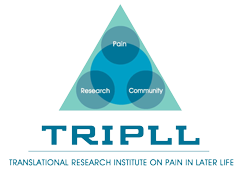Pain is a highly common, costly and frequently disabling disorder in later life. Prevalence studies estimate that as many as 30% – 40% of the population of older people in the community experience persistent non-cancer-related pain. Arthritis and arthritis-related diseases are the most common causes of pain in persons ages 65 years and older. Increased frailty is also strongly associated with pain in later life. Studies show that persistent pain is experienced by 46% to 55% of seniors receiving home care services and 68% – 83% of seniors living in nursing homes.
A substantial body of literature documents that pain is both highly underdetected and undertreated with advancing age. Underdetection and undertreatment is most problematic in nursing home or long term care facilities, which is particularly problematic given that it is estimated that up to 42% of older persons will spend time (receiving acute and/or long term care) in a nursing home.
Other types of pain also commonly occur in later life and contribute to substantial suffering. Approximately 1.5 million cases of cancer are diagnosed each year in the United States; the vast majority occurring in older persons. As many as 80% of persons diagnosed with cancer experience pain during the course of their illness and pain that occurs as a consequence of cancer treatment is increasingly recognized as a form of persistent pain.
Older adults are also at increased risk for acute pain problems, often occurring as a consequence of trauma, surgery and non-traumatic fractures. Approximately 2 million joint repair/replacement surgeries occur each year and post-operative pain puts older patients at risk for continued poor outcomes.
The consequences of untreated or inadequately treated pain are huge and include impaired quality of life and sleep as well as decreased immune functioning, cognition, and mobility. This pain is by far the most frequently cited symptom causing activity of daily living disability in later life. Persistent, unrelieved pain is also by far the strongest predictor of suicide in later life.
Lastly, evidence shows that there are significant disparities with respect to pain and pain-related disability, as well as access to care, among older adults of color. This issues is particularly important in New York City where older adults and the population at large is extremely diverse, with neighborhoods and communities of representing different ethnic backgrounds, religions, races, cultures, socioeconomic levels, etc.
